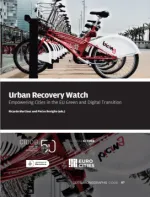Finland’s recovery and resilience journey: Helsinki metropolitan area on the path to green, digital and resilient transformation

In this study, we explore the involvement of the Helsinki Metropolitan Area, comprising Helsinki, Espoo, Vantaa and Kauniainen, in Finland’s recovery and resilience process, its strategic plan and the national funding calls, and we assess the influence of the Helsinki Metropolitan Area on the urban recovery landscape in Finland. To offer a comprehensive perspective, we will commence by outlining the challenges, process and plan related to recovery and resilience in Finland.
Based on the OECD1 outlook, Finland faces various economic challenges, such as the need to raise productivity and competitiveness, improve employment rates, address structural unemployment, and better align skills with market demands. To enhance productivity and competitiveness, it is important to prioritise research, innovation, education and skills, digitalisation and green transformation. Furthermore, strengthening health care access, particularly through e-health solutions, is essential for bolstering social resilience.
Finland’s National Recovery and Resilience Plan (NRRP) for 2021-2026 initially amounted to €2.085bn, but it was later revised down to €1.822bn (-13%) in June 2022.2 The NRRP utilises grants rather than loans from the Recovery and Resilience Facility (RRF). The original NRRP represents 0.9% of Finland’s GDP in 2019 and 0.3% of the entire RRF.3 On September 1, 2023, Finland updated its NRRP and secured a REPowerEU chapter on energy measures worth €127m from the European Commission.